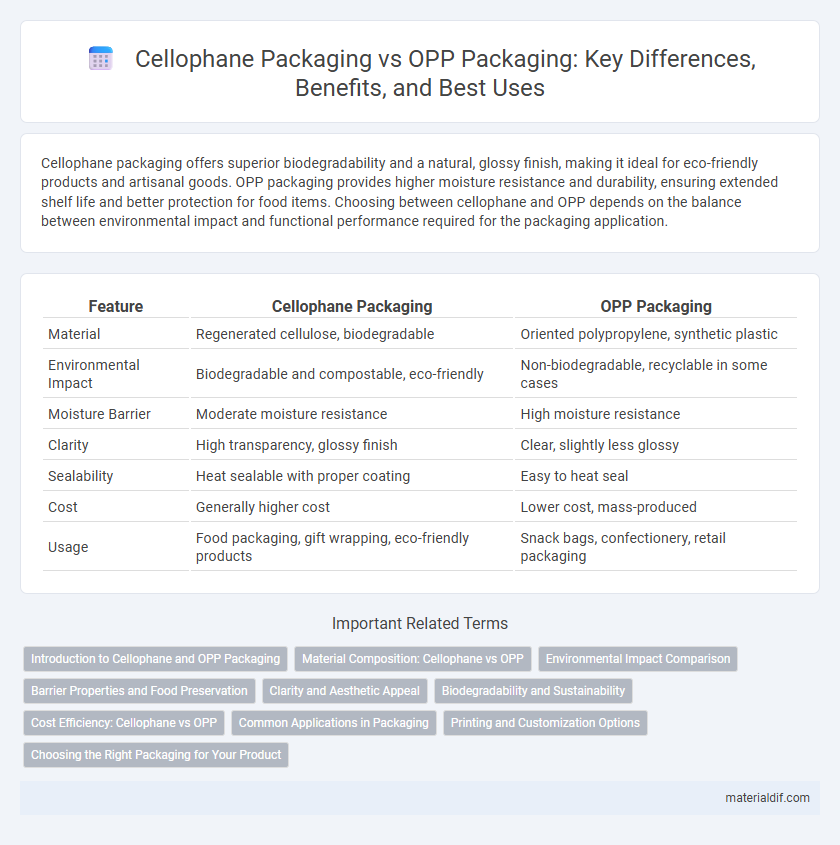Cellophane packaging offers superior biodegradability and a natural, glossy finish, making it ideal for eco-friendly products and artisanal goods. OPP packaging provides higher moisture resistance and durability, ensuring extended shelf life and better protection for food items. Choosing between cellophane and OPP depends on the balance between environmental impact and functional performance required for the packaging application.
Table of Comparison
| Feature | Cellophane Packaging | OPP Packaging |
|---|---|---|
| Material | Regenerated cellulose, biodegradable | Oriented polypropylene, synthetic plastic |
| Environmental Impact | Biodegradable and compostable, eco-friendly | Non-biodegradable, recyclable in some cases |
| Moisture Barrier | Moderate moisture resistance | High moisture resistance |
| Clarity | High transparency, glossy finish | Clear, slightly less glossy |
| Sealability | Heat sealable with proper coating | Easy to heat seal |
| Cost | Generally higher cost | Lower cost, mass-produced |
| Usage | Food packaging, gift wrapping, eco-friendly products | Snack bags, confectionery, retail packaging |
Introduction to Cellophane and OPP Packaging
Cellophane is a transparent, biodegradable film made from cellulose, widely used for packaging due to its excellent moisture barrier and breathability. OPP (Oriented Polypropylene) packaging is a synthetic, non-biodegradable film known for high clarity, toughness, and moisture resistance, making it popular in food and retail packaging. While cellophane offers eco-friendly appeal with natural compostability, OPP provides superior durability and heat-sealing properties essential for extended product shelf life.
Material Composition: Cellophane vs OPP
Cellophane is made from regenerated cellulose derived from wood pulp or cotton fibers, offering biodegradability and excellent oxygen barrier properties. OPP (Oriented Polypropylene) is a synthetic polymer composed of polypropylene molecules stretched to enhance strength, clarity, and moisture resistance but lacks biodegradability. The natural origin of cellophane makes it environmentally friendly, while OPP's plastic composition provides superior mechanical durability and moisture barrier performance.
Environmental Impact Comparison
Cellophane packaging is biodegradable and compostable, breaking down naturally within weeks when exposed to moisture and microorganisms, making it a highly sustainable choice. OPP (Oriented Polypropylene) packaging, while offering excellent durability and clarity, is derived from fossil fuels and is not biodegradable, contributing to long-term plastic pollution. The environmental impact of cellophane is significantly lower due to its renewable cellulose base and lower carbon footprint during production compared to petroleum-based OPP films.
Barrier Properties and Food Preservation
Cellophane packaging offers excellent oxygen and aroma barrier properties that help maintain the freshness and flavor of food products, making it ideal for short to medium shelf life applications. OPP packaging provides superior moisture resistance and mechanical strength, extending the shelf life of foods by preventing water vapor transmission and physical damage. Combining both materials can optimize food preservation by balancing breathability and moisture barrier effectiveness.
Clarity and Aesthetic Appeal
Cellophane packaging offers superior clarity and a natural gloss that enhances product visibility and appeal, making it ideal for showcasing fresh produce and delicate items. OPP packaging provides a shinier surface with excellent printability but can appear less transparent compared to cellophane, impacting the overall aesthetic appeal. Brands seeking a more natural, eco-friendly look often prefer cellophane for its biodegradable properties and crisp visual presentation.
Biodegradability and Sustainability
Cellophane packaging is derived from cellulose, making it fully biodegradable and compostable, which significantly reduces environmental impact compared to OPP packaging, a petroleum-based plastic with limited biodegradability and recyclability. Cellophane's renewable raw material source supports sustainability efforts by minimizing reliance on fossil fuels and decreasing plastic waste accumulation. Although OPP offers superior moisture resistance and clarity, cellophane remains the preferred option for eco-conscious brands seeking biodegradable, sustainable packaging solutions.
Cost Efficiency: Cellophane vs OPP
Cellophane packaging offers cost efficiency through its biodegradability and lower environmental disposal fees compared to OPP packaging, which, despite higher initial costs, provides superior durability and moisture resistance reducing product loss. OPP packaging tends to incur higher material expenses but can lead to long-term savings in supply chain due to enhanced shelf life. Businesses must weigh upfront costs against product protection benefits when choosing between cellophane and OPP for packaging solutions.
Common Applications in Packaging
Cellophane packaging is widely used for food products like bakery items, candies, and fresh produce due to its excellent breathability and biodegradable properties, which help maintain freshness. OPP packaging, favored in snack foods, confectionery, and frozen goods, offers superior moisture resistance and clarity, making it ideal for visually appealing product displays. Both materials serve crucial roles in packaging, with cellophane preferred for natural and eco-friendly branding while OPP excels in durability and barrier protection.
Printing and Customization Options
Cellophane packaging offers superior print clarity and vibrant color reproduction due to its natural cellulose base, making it ideal for high-quality visual branding. In contrast, OPP (Oriented Polypropylene) packaging provides more versatile printing options with better adherence to various ink types and allows for a wider range of customization techniques such as matte, gloss, and satin finishes. Brands seeking detailed, high-resolution graphics often prefer cellophane, while those requiring diverse surface textures and functional prints opt for OPP packaging.
Choosing the Right Packaging for Your Product
Cellophane packaging offers excellent biodegradability and clarity, making it ideal for eco-conscious brands seeking sustainable solutions. OPP packaging provides superior moisture resistance and durability, suitable for products requiring extended shelf life and protection. Select cellophane for natural appeal and compostability, while OPP remains the choice for barrier properties and high tensile strength.
Cellophane Packaging vs OPP Packaging Infographic

 materialdif.com
materialdif.com